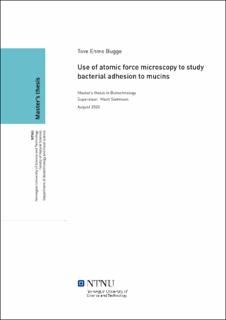| dc.contributor.advisor | Sletmoen, Marit | |
| dc.contributor.author | Bugge, Tove Enmo | |
| dc.date.accessioned | 2021-09-25T16:12:15Z | |
| dc.date.available | 2021-09-25T16:12:15Z | |
| dc.date.issued | 2020 | |
| dc.identifier | no.ntnu:inspera:56743445:34590785 | |
| dc.identifier.uri | https://hdl.handle.net/11250/2782603 | |
| dc.description.abstract | I høyere organismers indre organer, som luftveiene, mage- og tarmkanalen og det urogenitale system, dekkes overflateepitel av et slimlag, også kalt mucus. Mucus dekker også huden til amfibier, snegler og fisk. Mucus spiller en viktig rolle som en beskyttende barriere mot omgivelsene. En hovedkomponent i mucus er glykoproteinet mucin, som gir opphav til de viskoelastiske egenskapene til mucus. Muciner er et viktig mål for både normalflora og parasitter, og tjener som en kilde til karbon og energi for bakterier. Bakterier har utviklet en rekke mekanismer for å sikre kolonisering på måloverflater, og å studere egenskapene bak bakterieadhesjon er viktig for å forstå hvordan bakterier påvirker verten.
Målet med denne oppgaven var å undersøke Arthrobacters og Janthinobacteriums adhesjon til muciner isolert fra mucusdekte overflater hos storfe (BSM) og gris (PGM). Bakterieadhesjon ble målt ved bruk av atomkraftmikroskopi (AFM). AFM er et velegnet verktøy for å studere bakterieadhesjon til muciner. Metoden tillater målinger med levende celler, og målinger av enkeltmolekylære interaksjoner i nanometerskalaen. I denne oppgaven sammenlignes adhesjonsegenskaper til bakteriene før og etter mucinene ble behandlet med neuramindase, et enzym som fjerner sialinsyreenheter fra glykankjeder. Vi antok at bakteriene ville interagere med glykaner på mucinene, og at neuraminidasebehandlingen ville endre egenskapene til mucinene og påvirke bakterieadhesjon. Enkeltmolekylære par-interaksjoner ble analysert for å identifisere bruddkraften til enkle interaksjoner.
Kraftkurver fra AFM-målinger ble brukt for å bestemme deadhesionsarbeid og bruddkraften for bakterieinteraksjonen med mucinene. Resultatet indikerte at bindingsstyrken for både Arthrobacter og Janthinobacterium var svake til begge mucinene, men den var noe sterkere til BSM enn PGM. Etter behandling av mucinene med neuraminidase ble Arthrobacters adhesjonsegenskaper redusert, mens Janthinobacteriums adhesjonsegenskaper økte. Ved måling av enkeltmolekylære par-interaksjoner, ble bruddkraften til de molekylære bindingene mellom bakteriene og mucinene målt til å ligge i intervallet 0,1 – 0,3 eller 0,4 nN. Disse resultatene samsvarer med tidligere studier. | |
| dc.description.abstract | The mucosal barrier, covering the respiratory, gastrointestinal, and urogenital systems in higher organisms, plays an important part in the first line of defence against environmental dangers. Mucus also cover the skin of amphibians, snails, and fish. A major component in mucus is the glycoprotein mucin, which is responsible for the viscoelastic properties of the mucus. The mucin molecules are a major target for both microbiota and parasites and serve as a carbon and energy source for the bacteria. Bacteria have developed a high number of mechanisms to colonize their target surface, and it is important to study the adhesive properties of bacteria to better understand how they affect their host.
The aim of this thesis was to investigate the bacterial adhesion of Arthrobacter and Janthinobacterium to mucins isolated from mucosal surfaces found in pig (PGM) and bovine (BSM). Bacterial adhesion was measured with atomic force microscopy (AFM). AFM is a well-suited tool for studying bacteria adhesion to mucins as it allows measurements with live cells and measurements of single molecular interactions in the nanometer scale. This master thesis includes a comparison of the adhesion properties before and after the mucins are treated with neuraminidase, an enzyme that removes sialic acid units from glycan chains. We hypothesized that the bacteria would interact with the glycans on the mucins. We expected the neuraminidase treatment to alter the mucin-properties, thus also affecting bacterial adhesion. Single molecular pair interactions were also analysed to identify the rupture force of single interaction.
Force curves were obtained with AFM, and deadhesion work and rupture forces of the bacterial interaction with the mucins was determined. The results indicated that the binding strength of both Arthrobacter and Janthinobacterium to both mucins was weak. For both bacteria, the binding strength was slightly stronger to BSM than PGM. The adhesive properties of Arthrobacter were reduced after neuraminidase treatment of the mucins, but the adhesive properties of Janthinobacterium were elevated. When measuring single molecular pair interactions, the rupture force of the molecular bonds formed between both bacteria and the mucin coated surfaces were in the interval of 0,1 – 0,3 or 0,4 nN. These results are in line with previous studies. | |
| dc.language | | |
| dc.publisher | NTNU | |
| dc.title | Use of atomic force microscopy to study bacterial adhesion to mucins | |
| dc.type | Master thesis | |
